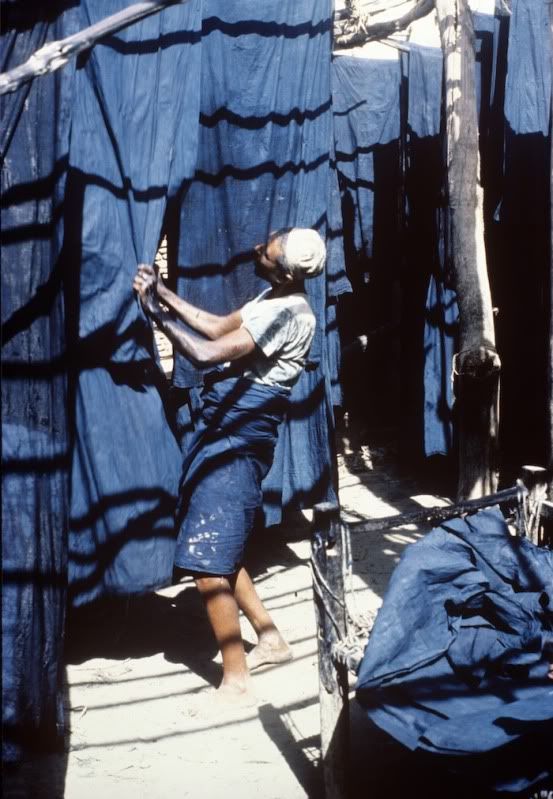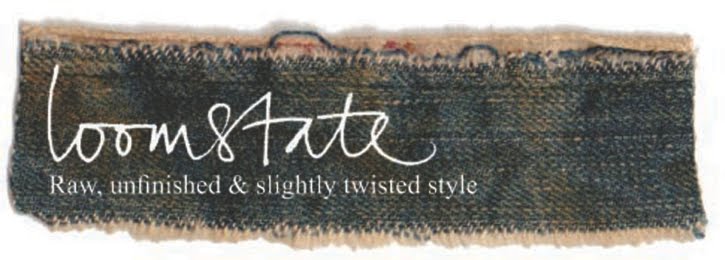 Shindigo Space 007: Indigo artwork by Hiroyuki Shindo, of artefacts dyed using the Sukumo technique. From the touring exhibition: Indigo, A Fabric To Dye For, Whitworth Art Gallery, University of Manchester. Courtesy of the artist. Photo: Joel Chester Fildes.
Shindigo Space 007: Indigo artwork by Hiroyuki Shindo, of artefacts dyed using the Sukumo technique. From the touring exhibition: Indigo, A Fabric To Dye For, Whitworth Art Gallery, University of Manchester. Courtesy of the artist. Photo: Joel Chester Fildes.
IN the first part of my discussion with Jenny Balfour-Paul, the author of Indigo, we discussed mainly Woad: the European indigo plant, from which indigo was extracted using a composting method, similar to the Japanese Sukumo technique. From the 18th century, this method of dyeing was supplanted using the much more sophisticated India techniques, via which Indigo was extracted as a cake, usually from the Indigo Tinctofera plant. This cake was more concentrated and easy to transport, and from the 18th Century onwards became the dominant method of indigo production - until, in turn, synthetic indigo took over, from around 1910.
In each case, these changes in production had profound economic and other effects; this is part of the fascination of this dyestuff, whose history is so intertwined with that of civilisation. And this is just one reason why I'd recommend Jenny's book, which gives many insights into the history of humanity, as well as our clothing. I've repeated the reader offer below.
I found it interesting when, the other day, you commented how indigo actually strengthens a yarn.
It does strengthen it - because it sits on top in layers and doesn’t penetrate right into fibre, unlike the dyes that use a mordant. If you look through a microscope there's a white core in the middle of indigo-dyed fibres. With some archaeological textile finds, everything will have rotted except the blue-dyed fibres. If you look at, say, at an old Persian carpet, sometimes the blacks have worn right down and the reds have gone flat, whereas the blue wool or silk is still lustrous.
Miles, designer for Levis Vintage and Made & Crafted asks: when was indigo introduced to the US? What strain was most popular and how long was it grown?
Indigenous indigo was already being used by people of the Ancient civilizations of the Americas – think of the famous ‘Maya blue’ paint, for example, that was made from indigo mixed with a certain white clay (this is an extraordinary story in itself). But the European colonising powers, by exploiting slave labour, created vast plantation systems from the 16th century and indigo was one of the main commercial plantation products, alongside coffee and sugar. The Spaniards produced good indigo in El Salvador, Guatemala, and southern Mexico, the French in the West Indies and Lower Mississippi. The British first grew indigo in Jamaica but by the 18th century indigo was, with rice, Britain’s main agricultural export from Florida, Georgia and South Carolina. Incidentally, indigo is often found in Caribbean shipwrecks and I have even dyed with indigo that has spent three centuries on the sea bed and it still dyes cotton the same clear colour as blue jeans!
Indigenous indigo was already being used by people of the Ancient civilizations of the Americas – think of the famous ‘Maya blue’ paint, for example, that was made from indigo mixed with a certain white clay (this is an extraordinary story in itself). But the European colonising powers, by exploiting slave labour, created vast plantation systems from the 16th century and indigo was one of the main commercial plantation products, alongside coffee and sugar. The Spaniards produced good indigo in El Salvador, Guatemala, and southern Mexico, the French in the West Indies and Lower Mississippi. The British first grew indigo in Jamaica but by the 18th century indigo was, with rice, Britain’s main agricultural export from Florida, Georgia and South Carolina. Incidentally, indigo is often found in Caribbean shipwrecks and I have even dyed with indigo that has spent three centuries on the sea bed and it still dyes cotton the same clear colour as blue jeans!
And that was indigofera?
Yes, but mainly the native Indigofera suffruticosa as opposed to the main one used in India which was Indigofera tinctoria. It’s more complicated than that of course, as seeds were tried out and traded for commerce.
And did they continue growing it until the early 1900s?
A bit yes. After the American Revolution in the late 18th century, and Britain’s loss of her American colonies, indigo ceased to be a major crop, but small amounts continued to be produced commercially in South Carolina and Georgia until the Civil War and abolition of slavery in the 1860s.
When Amoskeag were producing a lot of denim for Levi's and others between 1870 and 1915, where would their indigo have come from?
Most likely from India. It was grown in Bengal until 1859, when there was a ‘blue mutiny’ by the farmers (who resented being forced into growing it on their rice lands) and then many of the planters moved north to Bihar because they were so unpopular in Bengal. The French were also producing indigo in various places in the 19th century and Dutch grew much indigo in the Dutch East Indies, especially Java, but the lion's share of the indigo exports until 1900 came from India. But it's incredible how quickly synthetic indigo took over once it was launched on the market at the very end of the 19th century.
In the American plantations, were they producing indigo as cake? Did they use the Indian technique?
Yes they were producing the concentrated cakes that were so ideal for long-distance trade (being low bulk, insoluble, and high value). The system on American plantations was very much based on Indian methods and there was a lot of industrial espionage. The French in particular developed the most amazing technology for their West Indian plantations: there are pages and pages of prints of engravings illustrating the technology being devised to improve the system. After all, it was such big business then, though people have forgotten that. The wealth of cities such as Georgetown in South Carolina was based on indigo profits – just as cities like Toulouse and Erfurt grew wealthy on Europe’s woad trade in the Middle Ages.
You've written about the resurgence of natural indigo; can I ask about the last use of woad? I didn't realise it continued in use for military uniforms until comparatively modern times.
Yes, it was still being used until the early 1930s. Dyeing mills would use woad as an ingredient in vats made with imported indigo (and you could still buy natural Indian indigo at ‘dry-salter’ shops in London in the 1950s) – these vats were said to be better for the hard-wearing serge cloth (which was wool or part woollen) being made for policemen's and colonial uniforms. Britain’s last woad mill, in the fens of Lincolnshire, closed in 1932 and was demolished in the ‘50s... it would have made a fantastic museum today. But now there is a woad revival, a man called Ian Howard is growing woad again in the fens.
Finally, what does the future hold for natural indigo?
I think there are two things: on a smaller scale, I hope all the projects using natural indigo will expand, for many reasons, environmental for one. In places where dyers use synthetic indigo the water can't be reused – whereas when they return to organic indigo dye they can reuse the water, and also use the waste leaves for a rich compost. So on a smaller, more village scale, I hope many countries will turn back to natural indigo.
Then if you're talking about producing a billion pairs of jeans annually or whatever today’s figure is, you're never going to grow enough indigo. But you can do it for the top end, and I gather some companies are using non-toxic natural indigo for children's jeans. If we want to go on wearing indigo-dyed jeans on a vast scale, I think the idea of growing a bacterial, organic indigo in a lab, so we don't have to use nasty chemicals, would be the way to go - or even going the GM way, whatever misgivings one has. Imagine putting an indigo molecule into a weed, then indigo would be everywhere. Would that be a green crop? But one should be able to grow organic indigo in a lab, if that's not a contradiction, and use some sort of vat where you're feeding it with natural sugars and using a natural alkaline - perhaps we could take that from urine again? That may be some way off, of course - but things do sometimes change quickly.


Lengths of indigo-dyed cotton hanging in the courtyard at Bayt Muhammad ali Abud, Zabid, Yemen, 1983. Photo: Jenny Balfour-Paul
Reader Offer
Loomstate readers can get hold of Indigo at a discount price, 10% off with free postage in the UK: simply click here and enter the discount code Loomsgate 10. Offer is valid to 10 July, while stocks last, and is not available with any other promotion.



That was great Paul, loved it.
ReplyDelete